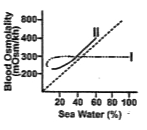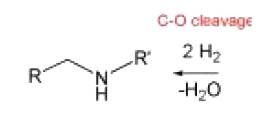Assertion: Some orgainsms can maintain internal homeostasis by means of physiological processes and are called "regulates."
Reason: Regulates can maintain internal homeostasis only up to a lilmit under stressful conditions.
If both Assertion and Reason are true and the reason is correct explanation of the assertion, then mark (1).
If both Assertion and Reason are true but the reason are true the reason is not the correct explanation of the assertion, then mark (2).
If Assertion is true but Reason is false, then mark (3).
If both Assertion and Reason are false, then mark (4).
The correct Answer is:C
Step by step video, text & image solution for Assertion: Some orgainsms can maintain internal homeostasis by means of physiological processes and are called "regulates." Reason: Regulates can maintain internal homeostasis only up to a lilmit under stressful conditions. by Biology experts to help you in doubts & scoring excellent marks in Class 12 exams.
Topper's Solved these Questions
- BOOK - CENGAGE BIOLOGYCHAPTER - ORGANISMS AND POPULATIONSEXERCISE - ARCHIVES (Choose the correct options)28videos
ORGANISMS AND POPULATIONS
- BOOK - CENGAGE BIOLOGYCHAPTER - MICROBES IN HUMAN WELFAREEXERCISE - ARCHIVES26videos
MICROBES IN HUMAN WELFARE
- BOOK - CENGAGE BIOLOGYCHAPTER - REPRODUCTION IN ORGANISMS EXERCISE - ARCHIVES8videos
REPRODUCTION IN ORGANISMS
Similar Questions
Nearly all plants and an overwhelming majority of animals are categorised as
(A) Conformers - They can maintain a constant internal environment
(B) Conformers - They cannot maintain a constant internal environment
(C) Regulators - They can maintain a constant internal environment
(D) Regulators - They cannot maintain a constant internal environmentView SolutionAssertion : Process of maintaining a constant internal environment is known as homeostasis .
Reason : Kidneys are excretory and homeostatic organs.View Solution
Knowledge Check
- Question 1 - Select One
Some organisms are able to maintain homeostasis by physiological (sometimes behavioural also) means which ensure constant body temperature, constant osmotic concentration, etc., are called
ARegulatorsBConformersCMigratoryDHibernating - Question 2 - Select One
Organisms that can maintain a constant internal temperature are called as
AhomoiothermicBpoikilothermicCoilgothermicDheterothermic - Question 3 - Select One
Organisms have evolved various mechanisms to maintain homeostasis to perform its physiological and biochemical functions. This can be obtained through
ARegulationBConformationCMigration or suspensionDAll
I. Conformers are the organisms that cannot maintain a constant internal environment.
II. 99% animals and nearly all plants cannot maintain their constant internal environments
III. During the course of evolution, the cost and benefits of maintaining a constant internal environment are discarded.
IV. Conformity is a condition in which an external challenge induces parallel internal changes.
V. Regulation is a condition in which external challenge elicits compensatory action to maintain the internal environment.View SolutionBlood osmolalities and the adaptable ranges of environmental salinities of two types of animals are shown in the graph below. Mark the correct descriptions of these animals.
A. Type I animals maintain more or less stable internal osmolality by physiological means.
B. Type II animals maintain blood osmolality within narrow physiological ranges un der different salinity conditions.
C. Type I animals are not likely to be found in estuaries or river mouths wher e fresh and salt water meet and the salinity fluctuates greatly.
D. Type II animals gain and lose water at equal rates and have no need to expend energy expelling water or salt from the body.
 View Solution
View SolutionRead the passage given below and answer the following questions:
Reduction of carboxylic acids and their derivatives plays an important role in organic synthesis, in both laboratory and industrial processes. Traditionally, the reduction is performed using stochiometric amounts of hydride reagents, generating stochiometric amounts of waste. A much more attractive, atom-economical approach is a catalytic reaction using H2, however, hydrogenation of carboxylic acid derivatives under mild conditions is a very challenging task, with amides presenting the highest challenge among all classes of carbonyl compounds. Very few examples of the important hydrogenation of amides to amines, in which the C-O bond is cleaved with the liberation of water (Scheme 1), were reported. C-O cleavage of amides can also be affected with silanes as reducing agents.

We have now prepared the new, dearomatized, bipyridine-based pincer complex 3, catalyst 3(Here refered as Cat. 3). Remarkably, it efficiently catalyzes the selective hydrogenation of amides to form amines and alcohols (eq 1). The reaction proceeds under mild pressure and neutral conditions, with no additives being required. Since the reaction proceeds well under anhydrous conditions, hydrolytic cleavage of the amide is not involved in this process.

(Balaraman, E., Gnanaprakasam, B., Shimon, L. J., & Milstein, D. (2010). Direct hydrogenation of amides to alcohols and amines under mild conditions. Journal of the American Chemical Society, 132(47), 16756-16758.)
In the following questions, a statement of assertion followed by a statement of reason is given. Choose the correct answer out of the following choices on the basis of the above passage.
Assertion: Aniline can be prepared from suitable amide using catalyst 3
Reason: The use of catalyst 3 is limited to aliphatic amides only.View SolutionRead the following statement carefully and give the answer :-
(A) The organism try to maintain the constancy of its internal environment this process is called homeostasis
(B) A very few lower vertebrate and invertebrate species are also indeed capable of regulation
(C ) An overwhelming majority (99%) of animals and nearly all plant cannot maintain a constant internal enviroment
(D) Some species have evolved the ability to conferm but only over a limited range of environment conditions beyond which they simply regulateView SolutionThe regulation by an organism of chemical composition of its blood and body fluids and other aspects of its internal environment so that physiological processes can proceed at optimum rates is called
View Solution

